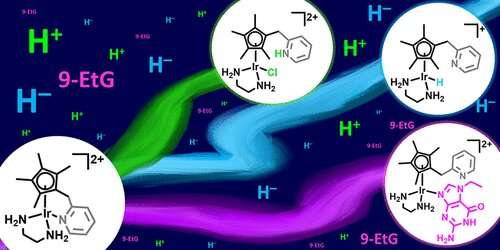Credit: Ana C. Carrasco
Chemotherapy is defined as the use of chemicals to reach and damage cancer cells. On its way toward the tumor, the drugs can affect healthy cells, as well. For example, cisplatin, a common drug used in clinical treatments, is not selective and causes unwanted secondary effects such as vomiting, fever and loss of sensitivity, among others. These effects often halt the treatment. It is of great importance to find new drugs that can be selectively activated in the tumor for more effective treatments. Understanding the interaction mechanism of new drug candidates within the cell nano-environment is the first step toward reaching the clinic.
The group of Ana Pizarro at IMDEA Nanociencia investigates the action of iridium complexes as anticancer compounds. These potential metallodrugs can be 100 times more effective than cisplatin, perhaps due to a precise targeting of the cell mitochondria, thus reducing the effective dose. The deadly action of iridium complexes is radically different. While cisplatin attacks nuclear DNA, changing its structure and preventing it from replicating, iridium metallodrugs appear to catalise transfer hydrogenation reactions—that is, they facilitate the transfer of hydrogen atoms between certain molecules, thus breaking the redox balance in the cancer cells and driving them to a certain death.
In their study, published in the ACS journal Inorganic Chemistry, Pizarro's group synthesized four new iridium complexes that were stable at pH 7. For two of these complexes, hydrogen transfer inside the cell proves to be plausible, as indicated by cytotoxicity experiments in which cells are co-incubated with innocuous amounts of a trigger molecule for the iridium catalytic reaction.
This catalytic reaction appears to compromise cell survival. Furthermore, the authors demonstrate that efficient acidic pH activation is also possible. The results open up the possibility of designing potent prodrugs activatable in the cancer cell microenvironment, drugs that can exert their action in a catalytic manner highlighting the great potential of the "tether design" on iridium(III) half-sandwich compounds.
More information: Ana C. Carrasco et al. Activation of the Ir–N(pyridine) Bond in Half-Sandwich Tethered Iridium(III) Complexes, Inorganic Chemistry (2020). DOI: 10.1021/acs.inorgchem.0c02287
Journal information: Inorganic Chemistry
Provided by IMDEA Nanociencia























